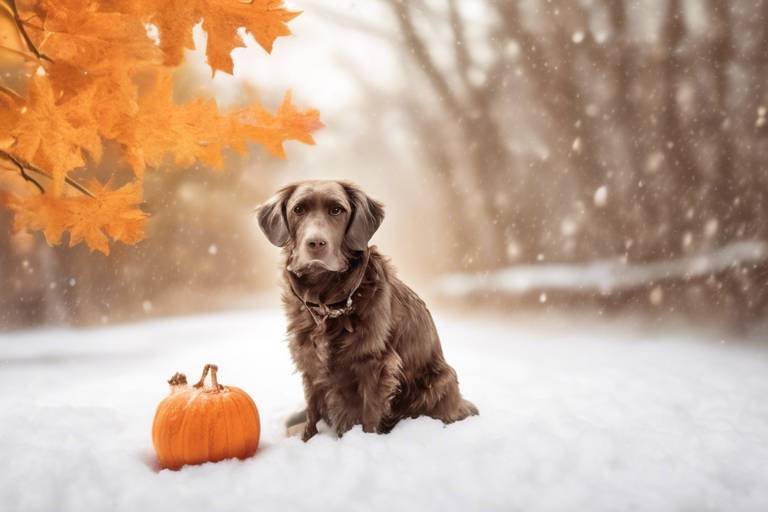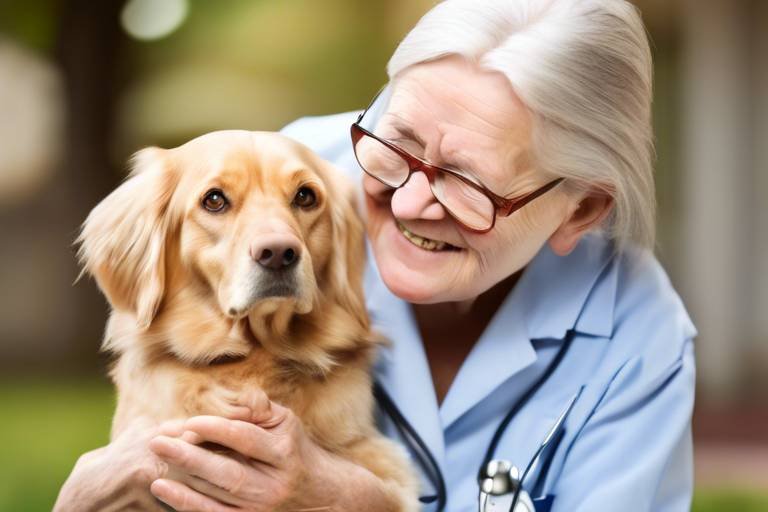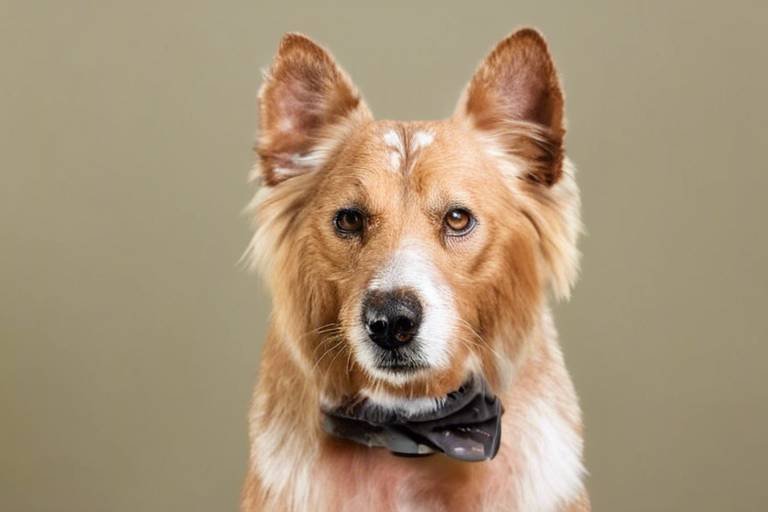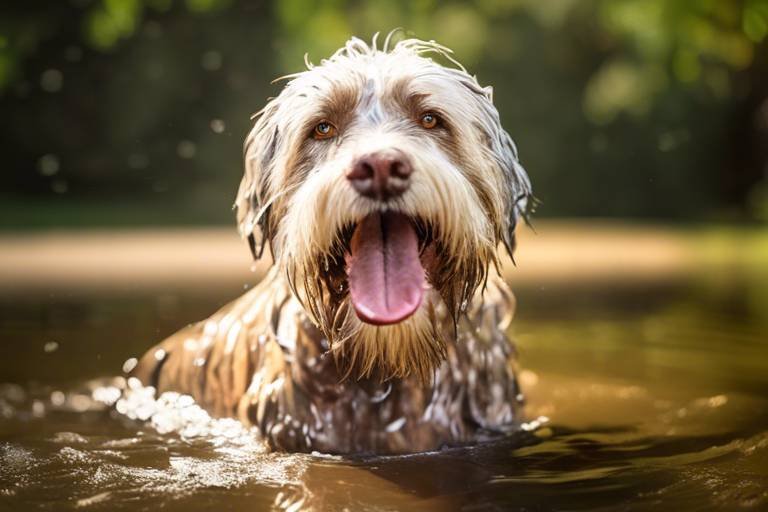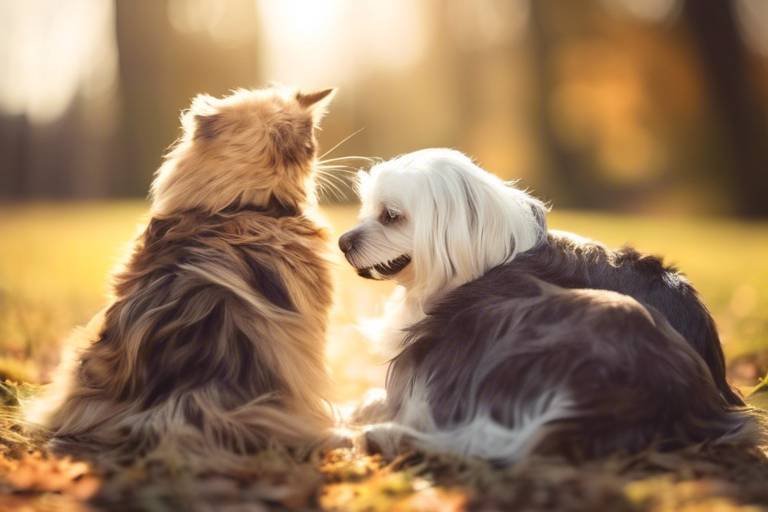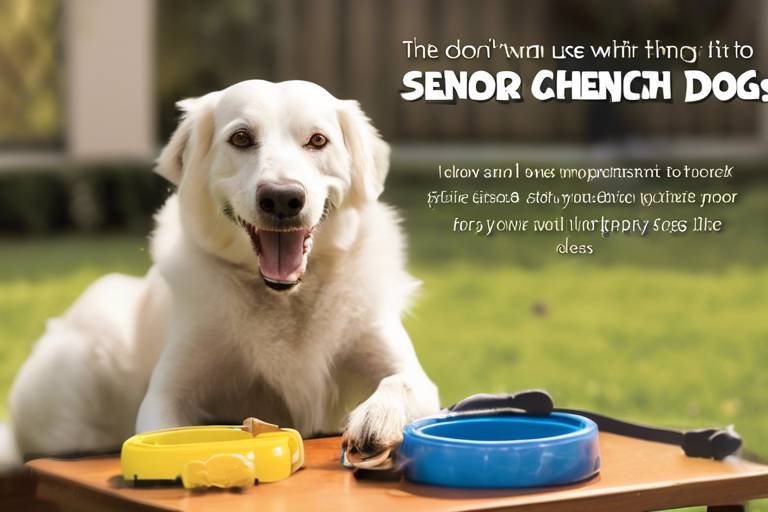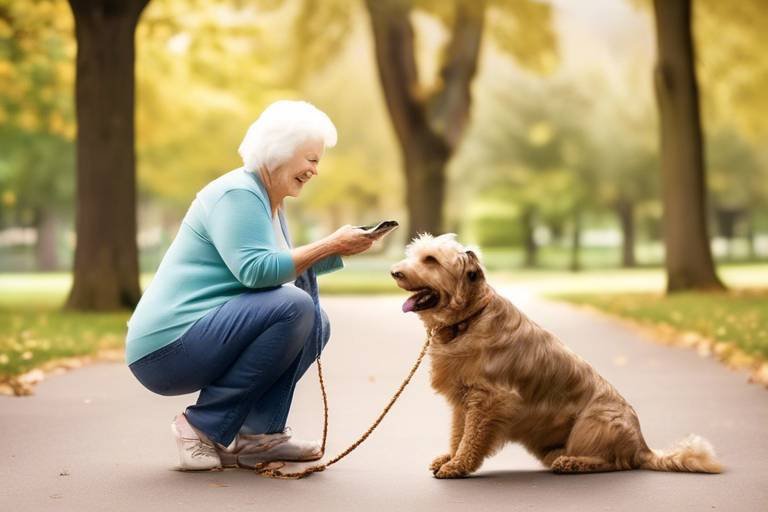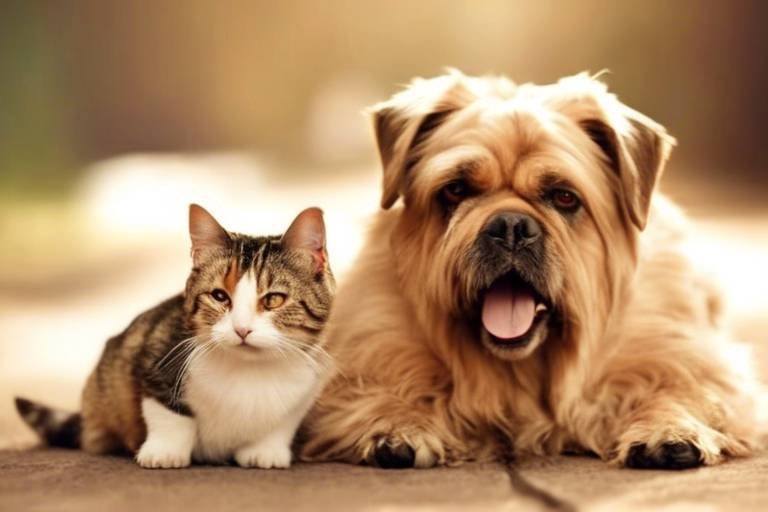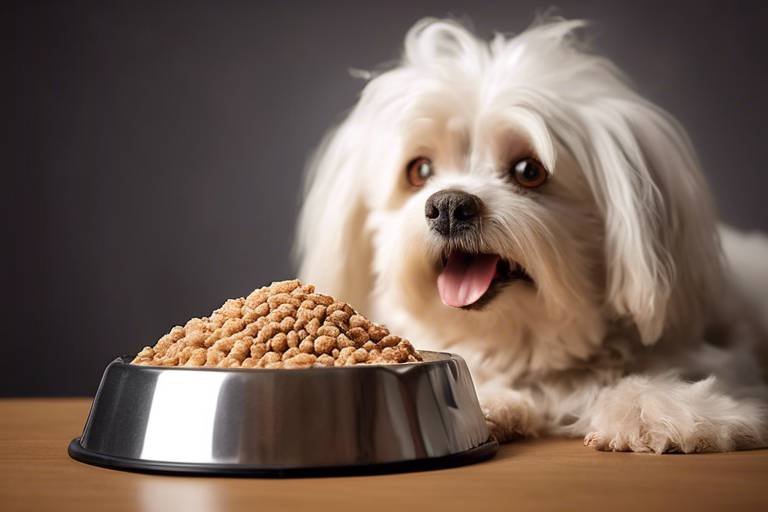Caring for Senior Pets During Seasonal Changes
As the seasons shift, so do the needs of our beloved senior pets. Just like we bundle up in cozy sweaters during winter or seek shade in the summer heat, our furry companions require special attention to ensure their health and happiness. Senior pets, those wise and gentle souls, often face unique challenges with each change in weather. It’s imperative for us as pet owners to be proactive, adapting our care routines to meet their evolving needs. This article delves into essential tips and considerations for maintaining the well-being of our senior pets throughout the seasonal transitions, focusing on health, comfort, and safety.
Understanding the specific challenges that accompany seasonal changes can empower us to make informed decisions. For instance, the cold winter months can exacerbate joint pain in arthritic pets, while the sweltering heat of summer can lead to overheating and dehydration. By recognizing these potential issues, we can take preventative measures—like providing extra blankets for warmth or ensuring that fresh water is always available. It’s all about creating an environment that supports their comfort and health, regardless of the weather outside.
Moreover, adjusting our senior pets' diets according to the seasons can play a significant role in their overall well-being. Just as we crave hearty soups in the winter and refreshing salads in the summer, our pets also benefit from tailored nutrition that aligns with the temperature and their activity levels. For example, during the colder months, increasing their caloric intake might be necessary as they expend more energy to stay warm. Conversely, in the heat of summer, lighter meals can help prevent discomfort and promote hydration.
In the following sections, we will explore various aspects of caring for senior pets during seasonal changes, including hydration needs, grooming practices, and creating a comfortable living environment. By keeping these considerations in mind, we can ensure that our senior pets not only survive but thrive through every season!
Seasonal changes can pose unique challenges for senior pets. Understanding these challenges helps pet owners prepare and adapt their care routines to maintain their pets' health and happiness. For instance, the transition from warm to cool weather can be particularly tough on older animals, whose bodies may not regulate temperature as effectively as they once did. This can lead to discomfort and even health issues if not addressed properly.
Moreover, changes in daylight hours can affect a senior pet's activity levels and mood. Shorter days might mean less time spent outdoors, which can lead to boredom and anxiety in some pets. Thus, it's vital to incorporate indoor activities that stimulate their minds and keep them engaged. A well-rounded approach to understanding these challenges will help you provide the best care possible for your furry friend.
As seasons change, so do the dietary needs of senior pets. Tailoring their nutrition to seasonal requirements can enhance their health and energy levels throughout the year. In winter, for example, pets may require more energy-dense foods to help maintain their body heat. On the other hand, during the summer months, it’s essential to keep their meals light and hydrating, incorporating fresh fruits and vegetables that can aid in cooling them down.
Hydration is crucial for senior pets, especially during extreme temperatures. Learn how to ensure your pet stays properly hydrated regardless of the season. In the heat, pets can easily become dehydrated, leading to serious health issues. Always provide fresh water and consider adding ice cubes to their bowl to make drinking more appealing. In winter, while pets may not feel as thirsty, it’s essential to encourage regular water intake to prevent urinary tract issues.
Recognizing signs of dehydration is vital for senior pets. Common symptoms include:
- Dry gums
- Loss of skin elasticity
- Lethargy
- Sunken eyes
If you suspect your pet is dehydrated, it’s crucial to consult your veterinarian immediately. Early intervention can prevent more severe health problems.
Implementing effective hydration practices can significantly benefit senior pets. Explore tips for encouraging water intake during hot and cold seasons:
- Offer ice chips as a treat during hot days.
- Provide multiple water bowls around the house.
- Incorporate wet food into their diet for added moisture.
Regular grooming is essential for senior pets, especially during seasonal transitions. As the weather changes, so does the need for grooming. During the warmer months, regular brushing can help remove loose fur and prevent matting, while in the winter, a thorough grooming can help keep their coat healthy and warm. Additionally, consider the type of grooming tools you use; softer brushes may be more comfortable for older pets with sensitive skin.
A comfortable living environment is crucial for senior pets during seasonal changes. This section outlines strategies to make your home cozy and safe for your furry companions. Ensure that their resting areas are warm and draft-free in winter and cool and shaded in summer. Providing soft bedding can significantly enhance their comfort, particularly for pets with joint issues.
Maintaining an appropriate temperature for senior pets is essential. Learn how to effectively manage indoor climates to ensure your pet's comfort year-round. Use fans or air conditioning in the summer to keep the air circulating, and during winter, ensure that they have access to warm spots, like heated blankets or pads. Regularly check the temperature in their sleeping areas to make sure it’s suitable.
Engaging in outdoor activities is important for senior pets. This section provides tips for safe and enjoyable outdoor experiences during various seasons. Short, gentle walks are ideal in both hot and cold weather, and always monitor your pet for signs of fatigue or discomfort. Remember to adjust the timing of walks; early mornings or late evenings during summer can help avoid the heat of the day.
Q: How often should I groom my senior pet during seasonal changes?
A: It depends on the season and your pet's coat type. Generally, you should groom them more frequently during shedding seasons (spring and fall) and ensure they are comfortable and mat-free year-round.
Q: What are the best foods for senior pets in winter?
A: Look for high-quality, energy-dense foods that provide the necessary nutrients and calories to help them maintain body heat. Consult your vet for specific recommendations based on your pet’s health.
Q: How can I tell if my senior pet is too hot or too cold?
A: Signs of overheating include excessive panting, drooling, and lethargy, while signs of being too cold include shivering, reluctance to move, and seeking warm places. Always keep an eye on your pet's behavior and adjust their environment accordingly.

Understanding Seasonal Challenges
As the seasons shift, our beloved senior pets face a myriad of challenges that can impact their overall health and well-being. The changes in temperature, humidity, and even daylight can affect their comfort and safety. For instance, older pets may have a harder time regulating their body temperature, making them more susceptible to heat stress in the summer and hypothermia during the winter months. This is particularly important for those furry companions who may already be dealing with chronic health issues.
Moreover, seasonal changes can also influence their activity levels. During the warmer months, senior pets might be more inclined to go outside and bask in the sun, but excessive heat can lead to exhaustion. Conversely, the colder months might make them less active, which can result in weight gain and muscle atrophy. As pet owners, it’s crucial to recognize these shifts and adapt our care routines accordingly.
In addition to temperature fluctuations, allergens can become a significant concern during seasonal transitions. Spring and fall often bring about increased pollen and mold, which can exacerbate allergies in senior pets. Symptoms such as itching, sneezing, and even respiratory issues may arise, indicating that your pet is struggling with the changing environment. Understanding these seasonal challenges helps us be proactive rather than reactive, ensuring our pets remain vibrant and happy throughout the year.
To effectively manage these challenges, consider the following key points:
- Temperature Sensitivity: Be aware of how your pet reacts to different temperatures and adjust their environment accordingly.
- Activity Levels: Monitor their energy and adjust playtime to suit the season, ensuring they get enough exercise without overexertion.
- Allergy Awareness: Keep an eye on your pet for signs of allergies and consult your veterinarian if symptoms persist.
By being mindful of these factors, you can create a supportive atmosphere for your senior pet, helping them navigate the seasonal changes with ease. Remember, a little extra care goes a long way in ensuring their comfort and happiness!

Adjusting Diet and Nutrition
As the seasons shift, so do the dietary needs of our beloved senior pets. Just like humans, pets experience changes in their metabolism and energy levels with the changing weather. The cold months may require more calories to keep warm, while the heat of summer can lead to a decrease in appetite. Understanding these variations can help you tailor your senior pet's diet to ensure they remain healthy, energetic, and happy throughout the year.
During the winter months, senior pets may benefit from a diet that is higher in calories and fat. This is because their bodies work harder to maintain warmth, which can lead to increased energy expenditure. Consider incorporating high-quality proteins and healthy fats into their meals. Foods rich in Omega-3 and Omega-6 fatty acids can help maintain their skin and coat health while providing the necessary energy. On the other hand, during the hot summer months, you might notice your furry friend becoming less active and possibly losing some weight. It’s essential to monitor their food intake and adjust accordingly. Providing lighter meals that are easier to digest can help maintain their health without overwhelming their system.
Another critical aspect of adjusting your senior pet's diet is ensuring they receive the right balance of nutrients. Senior pets often require diets that are lower in calories but higher in fiber to aid digestion and maintain a healthy weight. Look for pet food that is specifically formulated for older animals, as these typically contain the necessary vitamins and minerals tailored to their needs. Additionally, consider adding fresh fruits and vegetables to their diet. Foods like carrots, blueberries, and pumpkin can provide essential nutrients and antioxidants that support overall health.
Hydration plays a vital role in your pet's nutrition, especially as the seasons change. In the summer, the heat can lead to dehydration, while in winter, indoor heating can dry out the air, affecting your pet's hydration levels. Always ensure that fresh water is available, and consider adding moisture to their diet by incorporating wet food or adding water to dry kibble. This not only helps with hydration but also makes mealtime more enjoyable for your pet.
To help you keep track of your senior pet's dietary needs throughout the seasons, here’s a quick reference table:
| Season | Dietary Adjustments | Recommended Foods |
|---|---|---|
| Winter | Higher calories and fats | High-quality protein, Omega-3 and Omega-6 rich foods |
| Summer | Lighter meals, easier digestion | Fruits and vegetables, wet food |
In conclusion, adjusting your senior pet's diet and nutrition is crucial for their overall well-being as seasons change. By paying attention to their specific needs and making the necessary adjustments, you can ensure that they remain comfortable, healthy, and full of life. Remember, a well-nourished pet is a happy pet, and your efforts will surely be rewarded with wagging tails and purring cuddles!
Q: How can I tell if my senior pet is getting the right nutrition?
A: Monitor their weight, energy levels, and coat condition. A healthy pet should have a shiny coat, maintain a healthy weight, and be active. If you notice any changes, consult your vet for tailored dietary advice.
Q: Can I give my senior pet human food?
A: While some human foods are safe for pets, many can be harmful. Always check with your vet before introducing new foods to ensure they are safe and beneficial for your pet's health.
Q: How often should I feed my senior pet?
A: Senior pets may benefit from smaller, more frequent meals rather than one or two large meals. This can help with digestion and prevent obesity.
Hydration Needs in Different Weather
When it comes to our beloved senior pets, hydration is not just a seasonal concern; it’s a year-round necessity. However, as the weather changes, so do the hydration needs of our furry friends. Think of your pet's hydration like a finely tuned instrument: each season brings its own set of challenges that can affect how well it performs. During the sweltering summer months, the heat can lead to increased panting and sweating, which means your pet will need more water to stay hydrated. Conversely, winter can be deceptively dry, with indoor heating sucking moisture from the air, making it equally important to keep an eye on your pet's water intake.
So, how can you ensure your senior pet is getting enough hydration regardless of the weather? First off, it’s essential to provide fresh, clean water at all times. This should be a non-negotiable aspect of your pet care routine. But beyond just having water available, consider the temperature of the water. In summer, cold water can be refreshing, while in winter, slightly warmer water might encourage your pet to drink more. It’s all about making the experience enjoyable for them!
Additionally, you might want to incorporate water-rich foods into their diet. For instance, wet dog or cat food can significantly boost their moisture intake, especially during the hotter months. You can also offer ice cubes as a treat or freeze low-sodium broth into ice cubes for a fun and hydrating snack. These methods not only keep your pet hydrated but also add a bit of excitement to their routine.
As you adjust your pet's hydration strategies with the seasons, pay attention to their behavior. Are they drinking less than usual? Are they showing signs of lethargy or discomfort? Keeping a close eye on their habits will help you catch any hydration issues before they escalate. Remember, hydration is vital for maintaining healthy kidney function and overall well-being in senior pets.
In summary, being proactive about your senior pet's hydration needs as the seasons change is crucial. By ensuring constant access to fresh water, adjusting the temperature of their water, and incorporating hydrating foods into their diet, you can help your furry friend stay healthy and vibrant through every season.
Signs of Dehydration
Recognizing the signs of dehydration in senior pets is crucial for their health and well-being. As our furry friends age, they become more susceptible to various health issues, including dehydration, which can lead to severe complications if left unchecked. So, what should you look for? First and foremost, pay attention to your pet's drinking habits. If you notice that your pet is drinking less water than usual, it could be an early warning sign. Additionally, observe their behavior; lethargy or a lack of energy can indicate that they are not getting enough fluids.
Another important indicator is the condition of their skin. Gently pinch the skin on the back of your pet's neck and release it. In a well-hydrated pet, the skin should quickly return to its normal position. If it takes a while to settle back or remains tented, this may suggest dehydration. Furthermore, check their gums. Healthy gums should be moist and pink. If they appear dry, sticky, or pale, it's time to take action.
Other signs to watch for include:
- Sunken Eyes: If your pet's eyes look sunken or dull, it can be a sign of dehydration.
- Loss of Appetite: A decrease in food intake can also indicate that your pet is not feeling well, possibly due to dehydration.
- Bad Breath: An unusual odor can sometimes be linked to dehydration.
Being aware of these signs can make a significant difference in your senior pet's health. If you notice any of these symptoms, it’s advisable to consult your veterinarian promptly. Remember, prevention is always better than cure, especially when it comes to our beloved companions.
Q: How much water should my senior pet drink daily?
A: Generally, pets should drink about 1 ounce of water per pound of body weight each day. However, this can vary based on factors such as diet, activity level, and the weather.
Q: What should I do if my pet is dehydrated?
A: If you suspect dehydration, offer your pet fresh water and consider using an electrolyte solution designed for pets. If symptoms persist, consult your veterinarian.
Q: Can certain foods help with hydration?
A: Yes! Foods with high water content, such as wet dog or cat food, can help keep your pet hydrated. Additionally, adding water to dry kibble can also be beneficial.
Q: Are there specific breeds that are more prone to dehydration?
A: While all pets can suffer from dehydration, certain breeds, especially those with flat faces (like Bulldogs or Pugs), may have a harder time drinking water, making them more susceptible.
Best Hydration Practices
Keeping your senior pet well-hydrated is crucial, especially as the seasons shift. Just like us, pets can struggle with hydration, and it can affect their overall health. One of the best practices is to ensure fresh, clean water is always available. You might think that simply filling up their bowl is enough, but have you considered where you place it? Position the water bowl in a quiet, easily accessible spot to encourage your pet to drink more often. It's all about making hydration convenient for them.
Another effective strategy is to monitor their water intake. You could use a measuring cup to see how much water they drink daily. If you notice they’re not drinking as much as they should, it might be time to get creative. For instance, you can add a splash of low-sodium chicken broth to their water to make it more enticing. Just imagine how much more appealing a flavorful drink can be compared to plain water! Additionally, incorporating wet food into their diet can significantly boost their hydration levels. It’s like sneaking in a little extra moisture without them even realizing it!
During the warmer months, consider investing in a pet water fountain. Many pets are naturally drawn to flowing water, and a fountain can encourage them to drink more. It’s like turning hydration into a fun game for your furry friend! On the flip side, during colder months, it's essential to check that their water doesn’t freeze if they spend time outdoors. You don’t want your pet to go thirsty because of icy conditions. In extreme cold, consider using insulated bowls or even heated water bowls designed for pets.
To make it easier for you, here's a quick summary of some best hydration practices:
- Always provide fresh, clean water.
- Monitor daily water intake.
- Consider adding flavor to entice them.
- Incorporate wet food into their meals.
- Use a pet water fountain for increased interest.
- Ensure outdoor water doesn’t freeze in winter.
Remember, keeping your pet hydrated is not just about water; it's about their overall well-being. A well-hydrated pet is a happy pet, and as they age, your attention to their hydration needs can make a world of difference. So, as the seasons change, be proactive about their hydration, and you'll see the positive impact on their health and energy levels!
Q: How much water should my senior pet drink daily?
A: On average, a senior pet should drink about 1 ounce of water per pound of body weight each day. However, this can vary based on activity level, diet, and weather conditions.
Q: What are the signs of dehydration in senior pets?
A: Look for signs such as dry gums, lethargy, loss of skin elasticity, and decreased urination. If you notice any of these symptoms, consult your veterinarian immediately.
Q: Can I give my pet flavored water?
A: Yes! Adding a little low-sodium broth or pet-safe flavoring can encourage them to drink more. Just ensure it doesn’t contain any harmful ingredients.
Q: How can I ensure my pet stays hydrated during winter?
A: Keep their water bowl indoors or use heated outdoor bowls to prevent freezing. Also, encourage them to drink by offering warm water or adding wet food to their diet.
Grooming for Seasonal Comfort
When it comes to senior pets, grooming is not just about aesthetics; it's a vital part of their health and comfort, especially during seasonal transitions. As the weather changes, so do the grooming needs of our furry friends. In the warmer months, senior pets may benefit from a shorter coat to help them stay cool, while in the colder months, a thicker coat can provide much-needed warmth. But how do you know what’s best for your pet? It's all about observing their behavior and adjusting your grooming routine accordingly.
During spring and summer, shedding can become a major concern. Senior pets often have thinner, more delicate skin, which means they might be more sensitive to the heat. Regular brushing not only helps to remove loose fur but also stimulates the skin and promotes healthy oil distribution. A good grooming session can feel like a mini-spa day for your pet! Plus, it’s a great way to bond with them. Aim to brush your senior pet at least once a week, but during heavy shedding seasons, you might want to increase that frequency.
On the flip side, when fall and winter roll around, the need for grooming shifts. As temperatures drop, many senior pets can develop a thicker coat, but they still need regular grooming to prevent matting and to keep their skin healthy. It's important to check for any signs of discomfort or sensitivity, as older pets may have arthritis or other conditions that make them less tolerant of prolonged grooming sessions. If you notice your pet flinching or becoming restless, it might be time to take a break or adjust your technique.
Another aspect to consider is the type of grooming tools you use. For senior pets, opting for gentle brushes and combs can make a world of difference. Look for tools specifically designed for sensitive skin. Additionally, bathing should be done with care; using a moisturizing shampoo can help keep their skin hydrated, especially in dry winter months. Always ensure that you dry them thoroughly after a bath, as older pets can be more susceptible to chills.
Lastly, don’t forget about their nails! Regular nail trimming is essential to prevent discomfort and mobility issues. Senior pets can struggle with walking if their nails are too long, leading to a decrease in their overall activity levels. Aim to trim their nails every few weeks, and consider using a grinder instead of clippers if your pet is particularly anxious about nail grooming.
In summary, grooming is not just a routine; it’s a seasonal necessity for senior pets. By adjusting your grooming techniques and being mindful of their comfort, you can ensure that your furry companions remain happy and healthy throughout the year.
- How often should I groom my senior pet?
It depends on the season and your pet's specific needs. Generally, brushing once a week is a good start, but increase frequency during shedding seasons. - What grooming tools are best for senior pets?
Look for gentle brushes and combs designed for sensitive skin, and ensure you have a good pair of nail clippers or a grinder. - Is it necessary to bathe my senior pet?
Bathing is important, but it should be done sparingly. Use a moisturizing shampoo, and make sure to dry them thoroughly afterward. - How can I tell if my pet is uncomfortable during grooming?
Watch for signs like flinching, whining, or trying to escape. If they seem distressed, take a break and try again later.
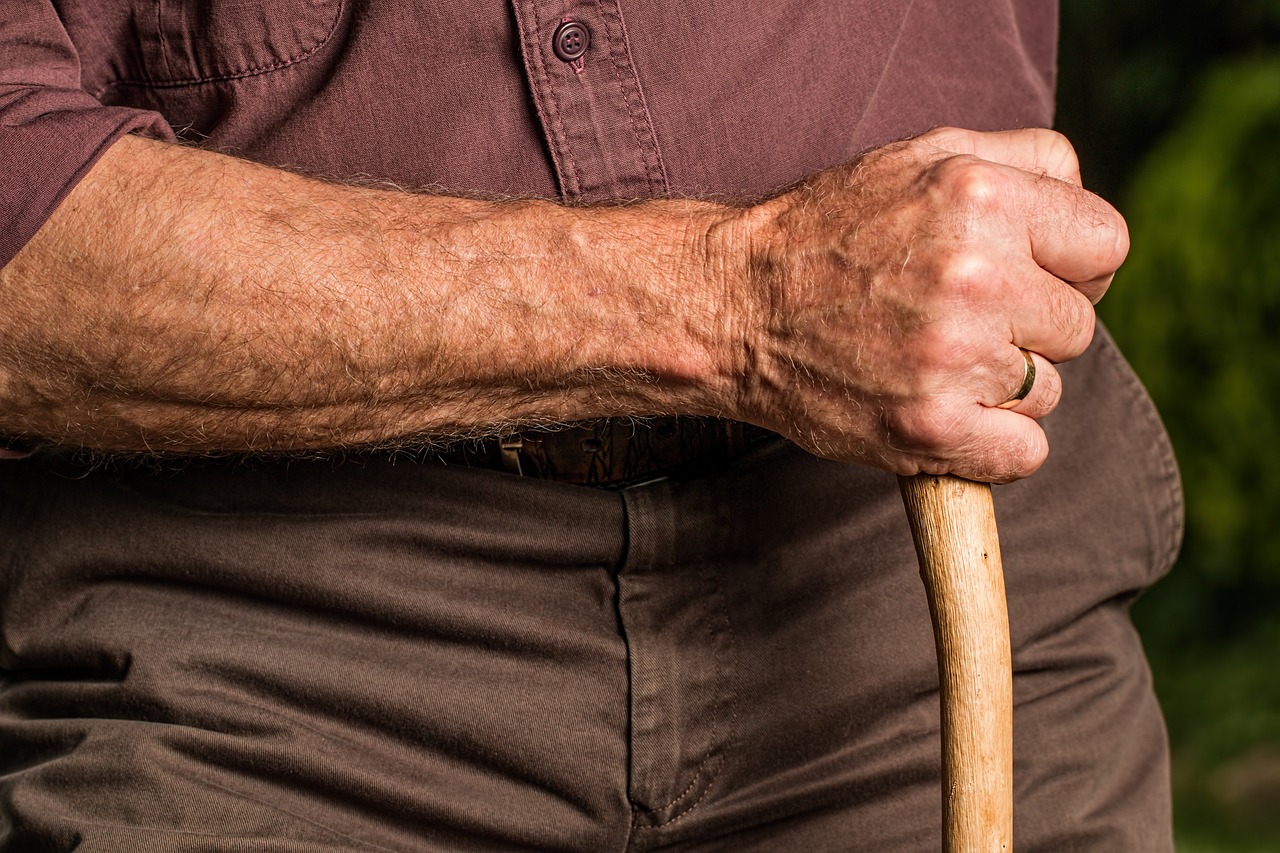
Creating a Comfortable Environment
Creating a comfortable environment for your senior pets is essential, especially as the seasons change. Just like humans, pets can feel the impact of temperature fluctuations, humidity, and other environmental factors. Imagine how you feel when the weather turns chilly or when the heat becomes unbearable; your furry friends experience similar discomforts. Therefore, it’s crucial to be proactive in making adjustments that cater to their needs. A cozy and safe environment not only enhances their daily life but also contributes to their overall health and well-being.
One of the first steps in ensuring comfort is to assess your home’s temperature control systems. During the hot summer months, it’s important to keep your home cool. You can achieve this by using air conditioning or fans and ensuring that your pet has access to shaded areas. Conversely, as the winter chill sets in, providing warmth becomes a priority. Consider investing in a good-quality heating system or using blankets and pet beds that retain warmth. Remember, senior pets often have less body fat and may struggle to maintain their body temperature, so keeping them cozy is key.
Another vital aspect of creating a comfortable environment is ensuring that your pet has a designated space where they feel safe and secure. This could be a quiet corner of your home, complete with their favorite blanket or bed. Think of it as their own little sanctuary. Make sure it’s away from drafts and noise, which can be particularly stressful for older pets. A pet cave or a soft, plush bed can provide them with a sense of security and comfort.
In addition to temperature and safe spaces, consider the layout of your home. As pets age, mobility can become an issue. To make their environment more accessible, you may want to rearrange furniture or remove obstacles that could pose a tripping hazard. If your senior pet struggles with stairs, think about creating a ramp or using baby gates to limit access to certain areas. This simple change can make a world of difference in their daily comfort and safety.
Finally, let’s not forget about the importance of clean air. Poor air quality can exacerbate respiratory issues in senior pets. Regularly change air filters in your heating and cooling systems, and consider using an air purifier to help eliminate allergens. Fresh air can make your home feel more inviting, not just for your pets but for you as well!
In summary, creating a comfortable environment for your senior pets involves a combination of temperature control, safe spaces, accessibility, and clean air. By taking these steps, you’re not just ensuring their comfort; you’re also showing them how much you care. After all, our furry friends deserve a cozy home where they can relax and enjoy their golden years.
- What temperature is ideal for senior pets? Generally, a comfortable indoor temperature for senior pets is between 68°F and 72°F (20°C to 22°C). However, individual preferences may vary.
- How can I help my senior pet stay warm in winter? Provide cozy blankets, heated pet beds, and ensure they have a warm spot away from drafts.
- Are there specific toys suitable for senior pets? Yes! Look for soft, easy-to-grip toys that won’t strain their teeth or joints.
- How often should I clean my pet's living area? Regular cleaning is essential; aim for at least once a week, or more often if your pet sheds a lot.
Temperature Control Tips
When it comes to ensuring the comfort of your senior pets, temperature control is absolutely essential. As the seasons shift, the temperature in our homes can fluctuate dramatically, which can be particularly challenging for older pets who may have health issues or decreased mobility. Imagine being wrapped in a blanket during a hot summer day or feeling the chill of winter without a cozy spot to curl up. This is why understanding how to maintain a comfortable environment for your furry friends is crucial.
During the warmer months, it’s important to keep your home cool. Air conditioning is a great way to regulate indoor temperatures, but if you don’t have it, consider using fans strategically placed to circulate air. You can also create a cool retreat for your pet by placing their bed in a shaded area away from direct sunlight. Additionally, cooling mats are an excellent investment that can help regulate their body temperature. Remember, senior pets are more susceptible to heat-related illnesses, so be vigilant about their comfort.
On the flip side, when winter rolls around, the cold can be just as harsh for senior pets. Make sure your home is adequately heated, and consider providing extra blankets or a heated pet bed to keep them cozy. It’s also wise to check for drafts around doors and windows, as these can make your home feel much colder than the thermostat indicates. For outdoor excursions, ensure your pet is bundled up with a warm coat or sweater, especially for short-haired breeds or those with thin coats.
Here are a few additional tips to effectively manage temperature for your senior pets:
- Monitor the temperature regularly with a thermometer to ensure it stays within a comfortable range (ideally between 68°F and 72°F).
- Provide plenty of fresh water, as hydration can help regulate body temperature.
- Limit outdoor time during extreme temperatures, whether it’s too hot or too cold.
In conclusion, being proactive about temperature control can significantly enhance your senior pet's quality of life. By taking simple steps to manage their environment, you can help ensure they remain comfortable, happy, and healthy throughout the changing seasons.
Q: How can I tell if my senior pet is too hot or too cold?
A: Look for signs of discomfort such as excessive panting, lethargy, or seeking cool places when it's hot. In cold weather, watch for shivering, reluctance to go outside, or curling up tightly. These are indicators that your pet is not comfortable with the temperature.
Q: Are there specific temperature ranges that are best for senior pets?
A: Generally, a comfortable indoor temperature for senior pets is between 68°F and 72°F. However, individual needs may vary based on breed, health conditions, and personal preferences.
Q: Should I adjust my pet's living space based on the season?
A: Absolutely! In warmer months, create shaded, cool areas for your pet to rest. In winter, ensure they have a warm, draft-free space with extra bedding or blankets to snuggle into.
Safe Outdoor Activities
Engaging in outdoor activities is essential for the physical and mental well-being of senior pets. Just like us, our furry friends thrive on fresh air and a change of scenery. However, as pet owners, we need to be particularly mindful of their age-related limitations and health concerns. So, what can we do to ensure our senior pets enjoy the great outdoors safely? Let's dive into some practical tips and activities that will keep your pet active without compromising their safety.
First and foremost, consider the weather conditions. Extreme heat or cold can be particularly tough on older pets. During the warmer months, early morning or late evening walks are ideal to avoid the scorching sun. On the flip side, in colder months, be sure to check the ground temperature; ice and snow can be harsh on their paws. A simple test is to place your hand on the ground for a few seconds—if it's too hot or too cold for you, it’s the same for your pet!
When planning outdoor excursions, it’s crucial to keep your pet's physical limitations in mind. Shorter, more frequent walks are often better than long treks. This not only prevents exhaustion but also allows your pet to explore at their own pace. Remember, every sniff is a story! If your senior pet enjoys socializing, consider visiting a dog park during off-peak hours. Just be sure to supervise their interactions and ensure they’re comfortable with other dogs.
In addition to walks, there are plenty of other safe outdoor activities to enjoy with your senior pet:
- Gentle Playtime: Soft toys or frisbees can provide light exercise without putting too much strain on their joints.
- Nature Exploration: Take leisurely strolls in a nearby park or nature trail. The new sights and sounds can stimulate their senses and keep them mentally sharp.
- Swimming: If your pet enjoys water, swimming can be an excellent low-impact exercise. Just ensure they are comfortable and safe in the water.
Before heading outdoors, always check that your pet is wearing a proper identification tag and is microchipped, just in case they wander off. Additionally, bringing along fresh water is a must to keep them hydrated, especially during warmer days. A collapsible bowl can be a handy accessory for quick hydration breaks.
Lastly, don’t forget to watch for signs of fatigue or discomfort during your outdoor adventures. If your pet seems to be lagging behind, panting excessively, or showing signs of distress, it’s time to take a break or head home. After all, the goal is to create positive experiences that foster a strong bond between you and your senior pet.
Frequently Asked Questions
- What are the common seasonal challenges for senior pets?
As the seasons change, senior pets can face various challenges such as temperature fluctuations, increased humidity, or dry air. These factors can exacerbate health issues like arthritis or respiratory problems. Understanding these challenges can help you adjust your care routine accordingly.
- How should I adjust my senior pet's diet during seasonal changes?
It's important to tailor your senior pet's diet to their seasonal needs. For example, in colder months, they might require more calories to maintain body heat, while in warmer months, lighter meals with more hydration can help keep them cool. Always consult your vet for personalized advice!
- What signs indicate my senior pet might be dehydrated?
Signs of dehydration in senior pets can include dry gums, lethargy, reduced appetite, and sunken eyes. If you notice any of these symptoms, it’s crucial to provide fresh water immediately and consult your veterinarian if the signs persist.
- What are the best practices to keep my senior pet hydrated?
Encouraging your pet to drink water can be done by providing fresh, clean water at all times, using pet water fountains, or adding water to their food. During hot weather, consider offering ice cubes or low-sodium broth to entice them to hydrate.
- How often should I groom my senior pet during seasonal changes?
Regular grooming is essential, especially during seasonal transitions. Aim to groom your senior pet at least once a week to remove loose fur and dirt, and to check for any skin issues. During shedding seasons, more frequent grooming may be necessary.
- What temperature should I maintain for my senior pet indoors?
For senior pets, maintaining a comfortable indoor temperature is key. Ideally, keep the thermostat between 68°F to 72°F (20°C to 22°C). Make sure they have cozy spots to rest away from drafts or direct heat sources.
- Can senior pets enjoy outdoor activities in all seasons?
Absolutely! However, it's important to adjust the type and duration of activities based on the season. In winter, short walks are great, while in summer, try early morning or late evening outings to avoid the heat. Always monitor your pet for signs of fatigue or discomfort.

